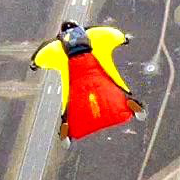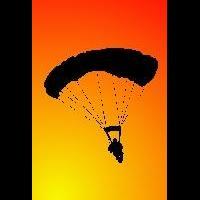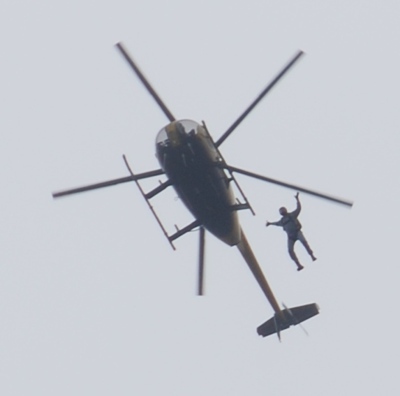Recommended Posts
UKFSDude 0
many thanks for that, its very descriptive. I have read everyones response and really like the idea of reducing the amount of unstowed line to a minimum. One question I do however have is once you have made your final loop (1/2 width of the D-Bag - step 4 in your instructions) you tuck the remaining loop underneath all the lines groups. One potential problem I see with this is that while this loop is being extracted at a 90 degree angle to the D-Bag during deployment there will be some force on all the line groups. If this force was enough to unstow any of the line groups you could end up with not only an out of sequence deployment but also a potential line dump. What are everyones thoughts on this analysis?
Blue skies,
fcajump 153
QuoteOne potential problem I see with this is that while this loop is being extracted at a 90 degree angle to the D-Bag during deployment there will be some force on all the line groups. If this force was enough to unstow any of the line groups you could end up with not only an out of sequence deployment but also a potential line dump. What are everyones thoughts on this analysis?
In my experience with my gear, this concern is mitigated by two observations:
1. The amount of tension required to release the 1/2 loop is (virtually) inconcequential and should flow with no resistance. Prove this to yourself by watching the deployment on the ground.*
2. The double-wrapped stows should be tight enough to keep the small force described in #1 to be of issue.
Also, had there been any drag of signifigance, there would have been line-burn at some point in the almost 500 jumps placed on each of two canopies. I have seen none.
Jim
* To the purists out there, I know that the dynamics of freefall deployment can be different, but I don't have the freefall video of the deployments to back it up... will have to work on that. ;-)
UKFSDude 0
DBCOOPER 1
Quote
Just a guess, but me thinks you might be biting off more then you (or anyone) can chew.
It has been tried. http://www.dropzone.com/cgi-bin/safety/detail_page.cgi?ID=19
Sparky
I listened to part of that.Got the wide chest strap and risers.I also did the "check with the manufacture" concerning dbag placement.Here was the correspondence.
-----Original Message-----
From: Curt Meyer [mailto:[email protected]]
Sent: Thursday, February 19, 2004 11:40 AM
To: [email protected]
Subject: Main bag placement in container
Would it be ok to place the dbag in facing straight down (against the back pad)instead of being oriented to the bottom of the container?Its a brand new (OCT 03)J-2 and the main is a Cobalt 150.It really takes some work to get to the recommended orientation and I worry some of the lines may get tangled. Curt
Hi Curt
Try Pulling up on the closing loop retainer with your pull up cord as you are rotating the bag in that should help. We do prefer that you try to get the correct orientation of the bag, as opposed to droping it straight in with lines on the back pad.
Sincerely
Warren
Warren Latham
Sun Path Products, Inc
4439 Skydive Lane,
Zephyrhills, FL 33542
Phone: 813 782 9242
Fax: 813 788 3057
Email: [email protected]
Web: www.sunpath.com
If the plane is unrecoverable then exiting is a very very good idea.
PEACEEEEEE
ANiz
pchapman 261
Perhaps one wants to avoid very soft (easily deformable) sections next to very hard, stiff sections. Either keep the whole flap stiff, or the whole flap soft. Sharp taper on a flap may also be beneficial.
That's just a theory for discussion, and I'm wondering to what degree manufacturers have taken it into account.
Flap stiffness was part of the discussion after a couple accidents where lines wrapped around the top flap of the European Omega rig, but mainly in relation to that particular design. Surprisingly, I didn't see it really discussed in relation to the fatality in Texas on a Javelin.
Some brief experiments:
I played around at home with some rigs and a spare piece of line, trying to catch the flap in both of two ways:
a) a full loop in a line catching around a flap, getting pulled in opposite directions, (fig. 1 of attachment) or
b) a line pulling from one side of the flap only (fig. 2).
For now I won't try to predict what's more likely in actual flight, and how it differs from ground tests. The fig 2 version is more like what was shown when people were experimenting with the Omega rig.
1. A mid 90's Racer. It has no plastic stiffener in the side flaps, unlike most rigs, only a webbing reinforcement near the grommet. This made it very hard for a loop of line pulled tight to catch the flap without sliding or twisting itself off. The Racer design is very good in that particular way.
2. An old Vector 2. Here it was relatively easy to catch a flap, because the side flaps are very thin and deformable, allowing the line to tighten on the flap, but with a heavy plastic reinforcement near the grommet, preventing the line from sliding off. (The side flaps are 2 layers of cordura, with no foam layer, on this particular rig -- Vector design did change over the years.) It's this sort of design that I worry about the most.
3. A Mirage G3. Here the tendency to catch a flap was fairly low. The side flap design tapered sharply (see fig. 3) which made the line tend to slide off without digging in and catching. There was still a less tapered part before getting to the hard plastic grommet reinforcement, but the line didn't easily catch there because that part had a light weight, flexible plastic stiffener in it. (The rig being fairly narrow might make it easier to taper the side flaps sharply.)
It all makes one wonder about how flexible flaps should be. They still need to bend, and avoid things like having cracking plastic stiffeners in them. But it may be good to have some stiffness other than just near the grommet. Additional binding tape, webbing, or sewing (which can greatly stiffen multiple layers of fabric) might be useful, especially along the top and bottom edges of side flaps.
(good way to learn and live)
Sparky
Quotethe important point, no matter how you stow, is to leave as little unstowed line as possible.
Bill -- I'm seeking clarification, since that statement conflicts with the manual for my canopy (Pilot). The manual states to leave 24-28 inches unstowed to prevent line twists.
Does your statement reflect a belief that the risk of a snagged line takes priority over the risk of line twists (makes sense) or that you disagree that more unstowed line reduces the risk of line twists?
Thanks for your time.
Doug
hookitt 0
QuoteHow are you ever going to be cool if you continue listen to people like Bill Booth and ask the manufacture before doing something?

Bill is only a senior rigger. Are you sure his advice is solid?
billbooth 10
Yes, and yes. As I said above, I remain unconvinced that leaving a lot of line unstowed makes line twists less likely. However, I do know that leaving a lot of line unstowed allows line/flap entanglements. However, I have not jumped every canopy, out of every rig. If you get line twists all the time by "short stowing" your lines, I'd try leaving a little more unstowed until the line twists went away. "As short as possible" is the key phrase.QuoteQuotethe important point, no matter how you stow, is to leave as little unstowed line as possible.
Bill -- I'm seeking clarification, since that statement conflicts with the manual for my canopy (Pilot). The manual states to leave 24-28 inches unstowed to prevent line twists.
Does your statement reflect a belief that the risk of a snagged line takes priority over the risk of line twists (makes sense) or that you disagree that more unstowed line reduces the risk of line twists?
Thanks for your time.
Doug
QuoteQuoteHow are you ever going to be cool if you continue listen to people like Bill Booth and ask the manufacture before doing something?

Bill is only a senior rigger. Are you sure his advice is solid?
But the rumor is that when he grows up he wants to be a Master rigger.
billbooth 10
Truth is...I hate packing. Jumping is a lot more fun.QuoteQuoteQuoteHow are you ever going to be cool if you continue listen to people like Bill Booth and ask the manufacture before doing something?

Bill is only a senior rigger. Are you sure his advice is solid?
But the rumor is that when he grows up he wants to be a Master rigger.







Just a guess, but me thinks you might be biting off more then you (or anyone) can chew.
It has been tried. http://www.dropzone.com/cgi-bin/safety/detail_page.cgi?ID=19
Sparky
Share this post
Link to post
Share on other sites